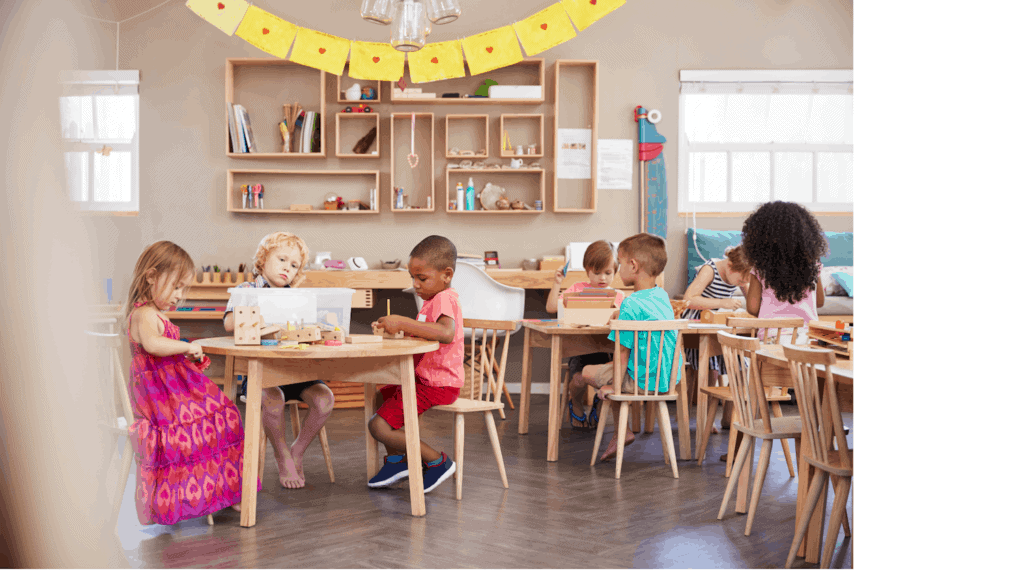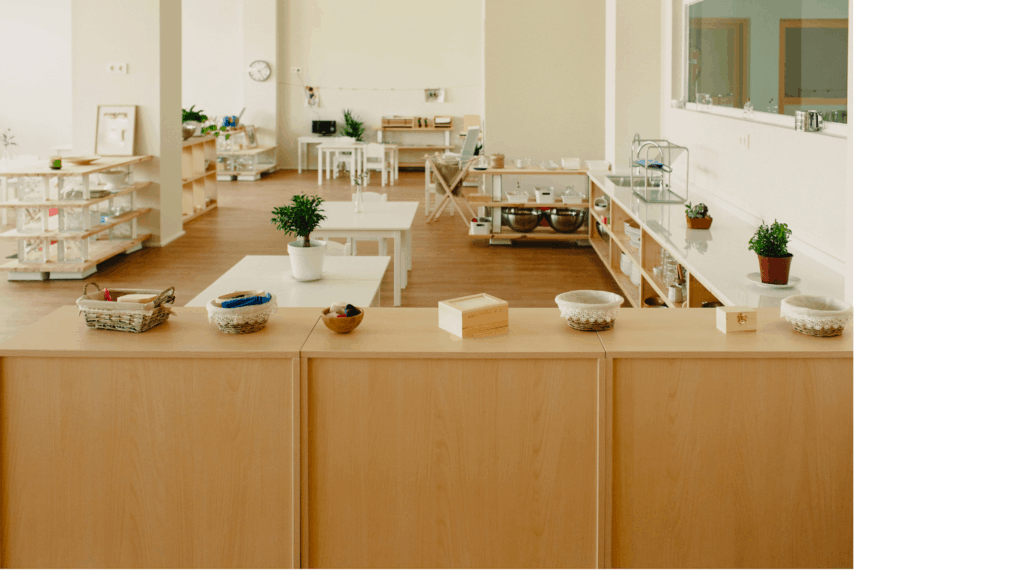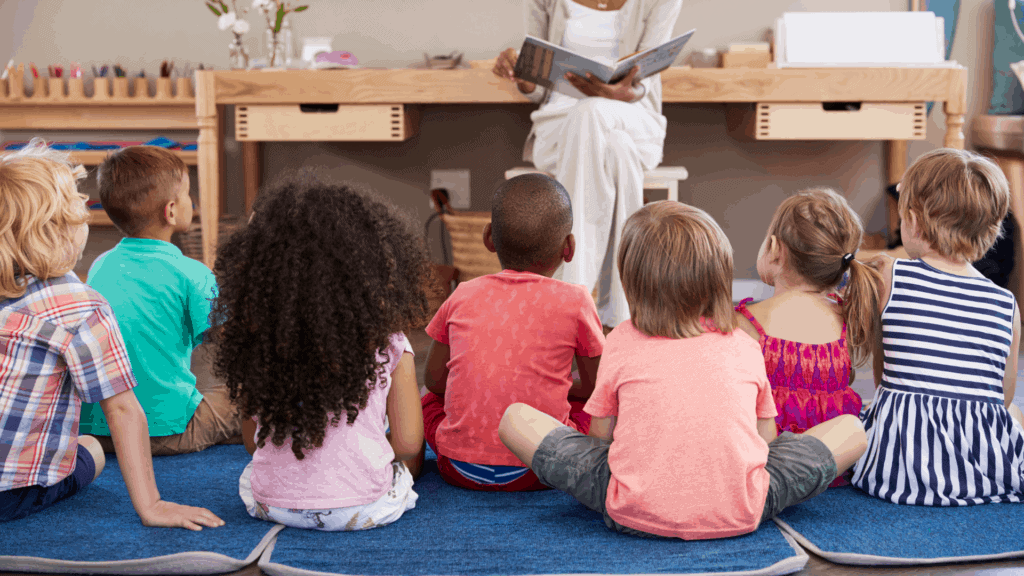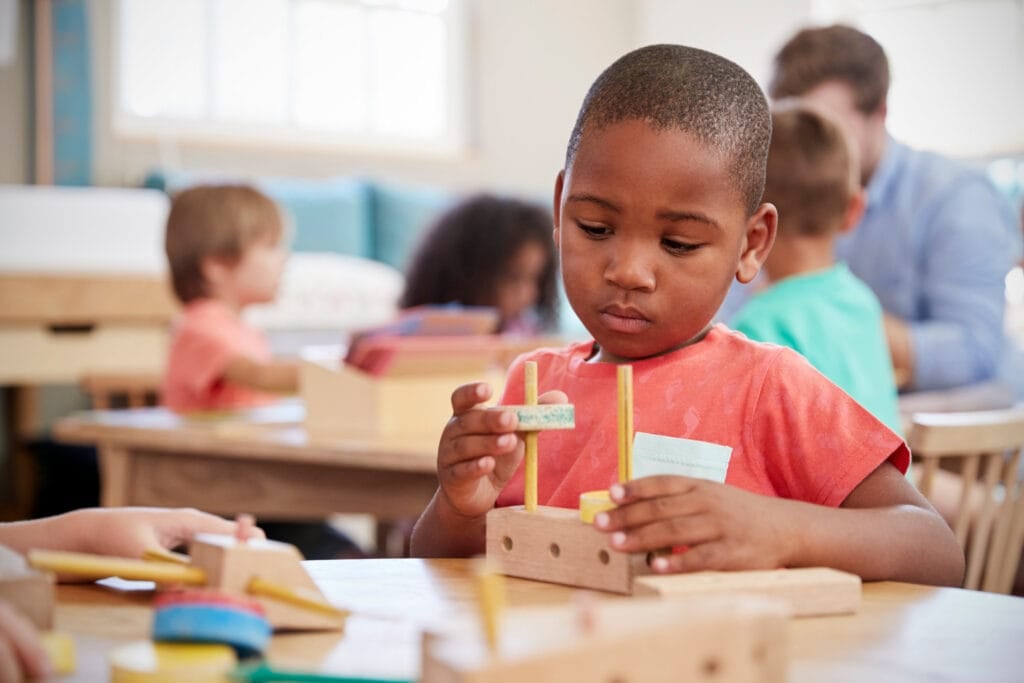If you’re looking into
A
Work cycles are one of the reasons that

On This Page…
- The Purpose of a Montessori Work Cycle
- What is a Prepared Environment?
- What Does a Work Cycle Look Like in a Montessori Classroom?
- How Long is a Montessori Work Cycle?
- Does a Work Cycle Start at the Same Time Every Day?
- What do Educators do During the Work Cycle?
- How do Work Cycles Change as Children Age?
- Can a Child Do Whatever They Want During a Work Cycle?
- Can a Child Choose Not to Work?
- Montessori Work Cycles and Children with Disabilities or Developmental Delays
- What Else Happens in a Montessori Day?
- Can Homeschoolers do Work Cycles?
- Do Work Cycles Work?
The Purpose of a Montessori Work Cycle
The work cycle is a key component of
Montessori educators are protective of the work cycle. It should never be interrupted by group work, specials, or the need to remove a child for extra one-on-one help. There is a good reason for this.
The work cycle is the time of day when students get to pick what they learn and spend time learning independently, and child-led learning that fosters independence is one of the cornerstones of Montessori education.
Not giving children enough time to delve into their learning by interrupting them undermines all of the work cycle’s benefits. Without enough time to delve into their learning experience and to complete their learning, children will have a fragmented and incomplete experience. This can lead to less learning or even a frustrating learning experience.
Here’s why
- It promotes independent learning.
- It lets children pursue the activities and topics that they’re most interested in.
- It gives children practice setting up an activity and cleaning it up, which encourages an organized mind.
- It allows children to gain all they need from a learning experience without interruptions or ending too soon.
- It lets children learn at their own pace.
- It gives children practice with prolonged focused attention.
- Generally, students will select increasingly challenging activities during the course of a 3-hour work cycle, which pushes them out of their comfort zone on their own terms.
For all of these benefits to be realized, it is essential that the work cycle not be interrupted unless absolutely necessary. Sometimes a student needs the teacher to introduce them to specific activities, or there is a safety issue that demands interruption, but most of the time, students should be allowed the satisfaction of completing the activity and the cycle.

What is a Prepared Environment?
The prepared environment is essentially the classroom, but a Montessori classroom will look different from a traditional classroom. The teacher prepares the environment for the students so that they can do the business of learning and living with as much independence as possible.
This means materials are within the child’s reach and typically on trays that make transporting the materials easier. It means that the classroom is organized in such a way that it is easy for children to put items back where they belong and clean up after themselves without needing help.
The prepared environment is also set up with developmentally appropriate activities for the children in the class. For example, you wouldn’t have a salt tray in a sixth-grade classroom or an activity that requires reading in a classroom where students have not learned to read yet.
A thoughtfully prepared environment is essential to have a productive and meaningful work cycle.

What Does a Work Cycle Look Like in a Montessori Classroom?
Any
- The Hustle and Bustle: When students first start a work cycle, there is usually a fair amount of noise and movement that goes on as students settle into the classroom. This is especially true for morning work cycles that start when children enter the classroom (which is very common).
- Mastered Activities: Within 30 minutes and often sooner, students will begin to settle into the work of the day. They will select an activity to do in the prepared environment. Usually, the first activity chosen is one they’ve done many times before. They may do this activity several times before putting it away.
- False Fatigue: This label is Maria Montessori’s own. During this phase, the student might look like they’re done, tired, or bored, but it is crucial that the educator not help them become busy. The noise level of the classroom will likely increase during this time.
- The Great Work: This is another label Maria
Montessori used. This phase involved the most important work, the work that will move the child forward in their education. Typically the activity chosen will be more involved, require more attention, and be all-around more challenging for the child to complete. - Clean up and Unwind: As students complete their activities, they will begin to clean up. The room will become noisier again, but it only because everyone is working at the same time to put away what they’ve been working on.
Generally, once the work cycle is over, the educator will lead the students in circle time, a time to enjoy stories and songs and relax.

How Long is a Montessori Work Cycle?
The typical length for a work cycle is three hours, but this is certainly not true across the board. The length of a work cycle depends on the age of the children in the classroom and their development. Here is an idea of what you can expect, but it may vary from classroom to classroom:
| Age of Children | Length of Work Cycle |
| Infant | There is not usually a work cycle for infants. Infants in a Montessori environment are free to explore their environment as much as possible. |
| Preschool Age | The work cycle is usually about 1-1.5 hours, but some educators see no issues with 2-2.5 hours at this age. |
| Pre-Kindergarten (4-5 years old) | The work cycle may be lengthened to about 2-2.5 hours. |
| Elementary Age and Older | Most work cycles will be 3 hours in length. In early grades, it may be 2-2.5 hours. In later grades, a second work cycle may be added in the afternoon. There is no specific grade when transitions happen. It varies between schools and teachers. |
You might expect middle school students to have longer work cycles than first graders, but that just isn’t the case. You have to keep in mind how you feel after three hours of meaningful and engaging work.
Does a Work Cycle Start at the Same Time Every Day?
In childhood education, especially in the early years, it is always best to lean into routines. This is why many classrooms do the same types of activities at the same time every day.
A traditional school may start with calendar time or circle time before getting into the work of the day, but at
The rhythm of the day is important because children feel most secure when they know what is happening during each part of the day.
So, it is best to start the work cycle around the same time every day.
What do Educators do During the Work Cycle?
During the work cycle, the children should be independently pursuing learning. The teacher should be as hands-off as possible. But what does the teacher do during this three hour period?
A lot of things, actually! Here are some things you’ll see teachers doing during a work period:
- Observing the classroom and assessing how the children are doing academically.
- Making sure students are respecting each other’s needs for quiet and calm to do their work.
- Ensuring the safety of each student.
- Redirecting students who may need that kind of support to complete a task.
- Showing children how to complete activities that they’ve never tried before.
- Supporting children only if they need it.
So, it isn’t exactly a moment for a teacher to sit down and relax. They are still actively engaged in the classroom during work cycles.

How do Work Cycles Change as Children Age?
As a child ages, what the day looks like in a Montessori classroom changes too. You’ll notice that the older a child becomes, the more independent they become and the more responsible for their own learning.
How Children are Grouped in Montessori Schools
Before we get into how the work cycle changes, it is important to know that most Montessori schools place students into multiage groups. Here are the groupings most often found in
- Preschool: Ages 3-6
- Elementary school: one group of ages 6-9 and one group of ages 9-12
- Secondary school: one group of ages 12-15 and one group of ages 15-18
There are many good reasons that Montessori schools are arranged this way, but the most important reason is that it gives older students the opportunity to be leaders and because children mature at different rates. It makes for a diverse classroom setting where everyone can succeed, and no one feels like they’re lagging behind.
Subjects Covered in Montessori Education
The subjects covered at each stage are largely the same, but they are adjusted to meet the student’s developmental needs. For example, students in preschool or Kindergarten might learn the continents of the world using a map. Older students might learn to draw each continent or may learn where the countries of Africa are located.
However, in preschool, there is less pressure to encourage the students to choose activities from a variety of subjects. Once children are in elementary school, and definitely by the time they are in middle and high school, it becomes more important that they select activities from all the subjects.
Usually, a checklist or diary is used by the students to write out which activities they pursued so that they don’t forget a subject.
The core subjects covered in
- Practical Life
- Language
- Mathematics
- Science
- Social Studies
- Sensorial
Sometimes these are called by different names. For example, social studies might be called cultural studies. Schools also usually include movement activities and the arts.
Activities For Montessori Work Cycles By Grade
The kinds of activities you’ll see at each stage will be different, although the change tends to be gradual. The student will hardly notice a difference in most cases.
Preschool
- Number cards with objects to count
- Salt tray for practicing letters
- Puzzles of all kinds
- Cleaning toys using a spray bottle, brush, and a dry towel
- Transferring activities like using tweezers to move objects from one container to another
- Sorting activities like sorting kinds of animals or colors
- Painting and craft activities
Elementary School
- Practical life skills like preparing snacks or sewing
- Language activities like arranging words into sentences, spelling words with a movable alphabet, or writing stories
- Math using hands-on materials like
Montessori beads, number rods, and counters - Geography by studying, creating, and exploring maps
Secondary School
- Hands-on learning activities like starting a business, conducting science experiments, drawing, and writing with a purpose beyond class assignments
- More group projects than in previous years
- Individualized learning plans
- Real-world experiences by leaving the school and engaging with the world
You see that by secondary school, children are working independently. Their work cycles consist of less prepared activities and more activities chosen by the child and the teacher to accomplish a goal. Of course, this is tempered slightly by educational regulations in some areas of the world.
There are not as many Montessori secondary schools out there as there are elementary and preschool. How each school translates the

Can a Child Do Whatever They Want During a Work Cycle?
A child is not permitted to do whatever they want if what they want to do is disruptive to others’ learning. During a work cycle, a child must select activities available in the prepared environment, and they must use them in an appropriate way.
Much of the earlier years in
Additionally, once children enter elementary school, teachers gently encourage students to select activities across all subjects so that they are well-rounded.
Can a Child Choose Not to Work?
Most
If it is a frequent occurrence, then getting to the root of the problem is necessary. Why is the child tired? Or what about the prepared environment isn’t engaging them?
Montessori Work Cycles and Children with Disabilities or Developmental Delays
Work cycles are fantastic for children with disabilities or developmental delays because they get to choose activities that are engaging to them. They may need more frequent redirection, more support, or more time to master an activity, but this depends on the unique challenges they face.
For the most part, children with disabilities or developmental delays do quite well in a
Anyone one-on-one instruction or therapies must be conducted before or after the work cycle. It is just as important that they get an uninterrupted work cycle as it is for other children.
What Else Happens in a Montessori Day?
It may sound like the work cycle is where all the learning happens in a
- Circle time
- Lunch, and sometimes snack times
- Lessons
- Group work
- Specials like gym, art, and music
- Assemblies
- Outdoor time
So there is much more to the day than the work cycle, but the work cycle is the heart of the day, and as children get older, most schools increase the amount of time spent doing work cycles because of that.
Can Homeschoolers do Work Cycles?
Hands down, yes. Many homeschooling families integrate the
The critical thing to remember when creating work cycles for homeschool is that most of the home is the prepared environment. This means that the home must be arranged in such a way that children can independently move through their day.
In many ways, a Montessori homeschool is a Montessori lifestyle.
Do Work Cycles Work?
You might be a little skeptical about letting kids pursue their own learning without a teacher directing them. It’s completely normal. Most people had that kind of experience in school.
But work cycles do work, and they work in the long term. They become independent and life long learners capable of tackling the challenges of learning a new skill with resilience and dedication. The work cycle is what makes it possible.







